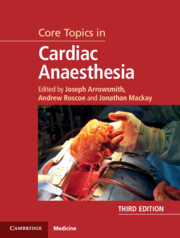Book contents
- Core Topics in Cardiac Anaesthesia
- Core Topics in Cardiac Anaesthesia
- Copyright page
- Dedication
- Contents
- Contributors
- Reviews of the First Edition
- Preface to the Third Edition
- Preface to the First Edition
- Foreword to the First Edition
- Abbreviations
- Section 1 Routine Cardiac Surgery
- Section 2 Anaesthesia for Specific Procedures
- Section 3 Cardiac Catheter Laboratory Procedures
- Section 4 Paediatric Cardiac Surgery
- Section 5 Cardiopulmonary Bypass
- Section 6 Advanced Monitoring
- Chapter 30 Cardiovascular Monitoring
- Chapter 31 Neurological Monitoring
- Section 7 Transoesophageal Echocardiography
- Section 8 Miscellaneous Topics
- Index
- References
Chapter 30 - Cardiovascular Monitoring
from Section 6 - Advanced Monitoring
Published online by Cambridge University Press: 12 May 2020
- Core Topics in Cardiac Anaesthesia
- Core Topics in Cardiac Anaesthesia
- Copyright page
- Dedication
- Contents
- Contributors
- Reviews of the First Edition
- Preface to the Third Edition
- Preface to the First Edition
- Foreword to the First Edition
- Abbreviations
- Section 1 Routine Cardiac Surgery
- Section 2 Anaesthesia for Specific Procedures
- Section 3 Cardiac Catheter Laboratory Procedures
- Section 4 Paediatric Cardiac Surgery
- Section 5 Cardiopulmonary Bypass
- Section 6 Advanced Monitoring
- Chapter 30 Cardiovascular Monitoring
- Chapter 31 Neurological Monitoring
- Section 7 Transoesophageal Echocardiography
- Section 8 Miscellaneous Topics
- Index
- References
Summary
When the rapid detection of haemodynamic change is imperative, the ‘gold standard’ is direct arterial pressure monitoring. Other indications for invasive arterial pressure monitoring include severe underlying cardiovascular disease, the inability to obtain indirect measurements and the need for frequent blood sampling. While the radial artery is the most frequently used site, other commonly used arterial cannulation sites include the femoral, brachial, axillary and dorsalis pedis arteries. Complications of arterial cannulation include haemorrhage, thrombosis, vasospasm, distal ischaemia, dissection, infection, unintentional arterial drug administration, pseudoaneurysm and arteriovenous fistula formation.
- Type
- Chapter
- Information
- Core Topics in Cardiac Anaesthesia , pp. 223 - 229Publisher: Cambridge University PressPrint publication year: 2020



